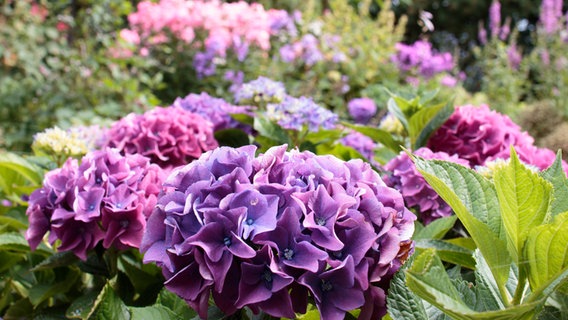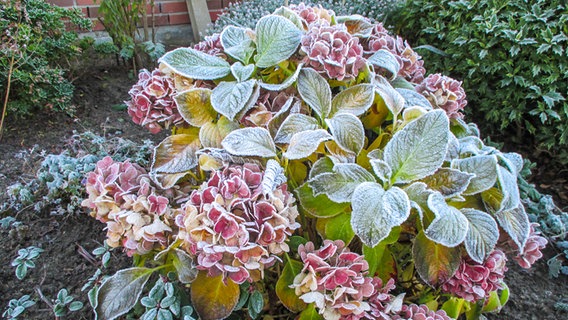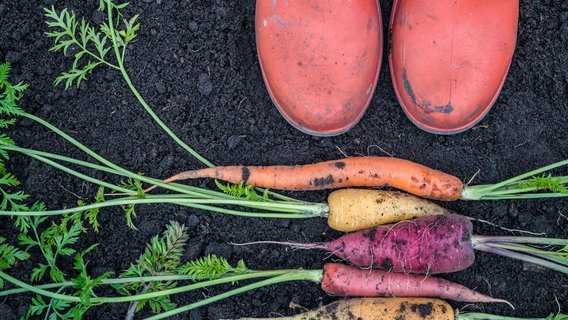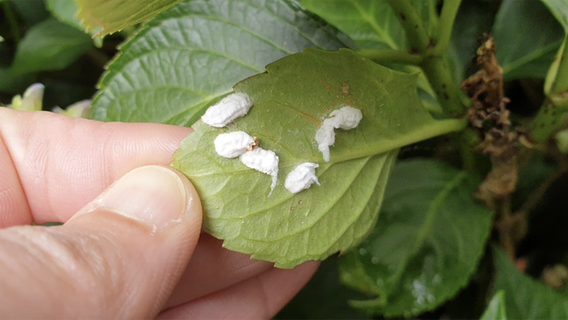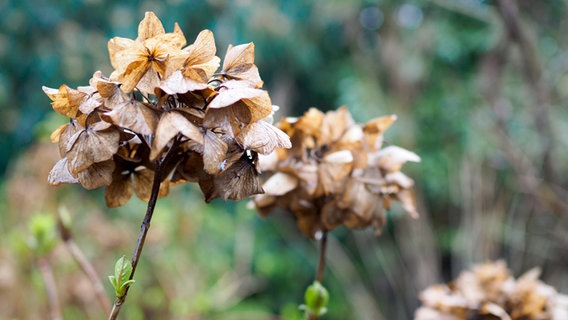
Caring for, planting and overwintering hydrangeas | NDR.de – Guide – Garden
As of: April 30, 2024 10:22 a.m
Hydrangeas beautify the garden with their pretty umbels. If they grow in the right location, the effort required for care is not particularly high. However, the plants need a lot of water.
For a long time they were considered old-fashioned, but today they are blooming again in many gardens: hydrangeas (Hydrangea). The best known is the garden hydrangea, which is also known, among other things, as the farmer’s hydrangea. Naturally their flowers are purple, pink or white. Depending on the variety, the flowering period is from June to September. The location should ideally be in partial shade and the soil should be nutrient-rich and not compacted.
Care: Water hydrangeas vigorously
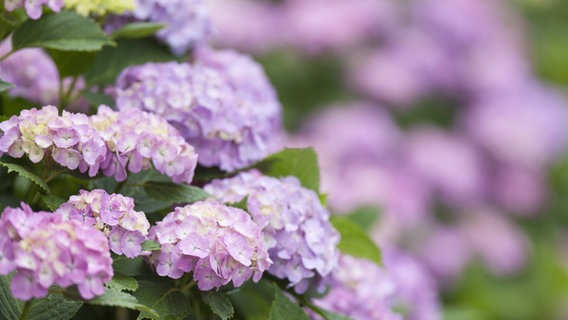
Hydrangeas require a lot of water.
The general rule is: Hydrangeas love water, so the soil must be kept moist, especially in dry and warm weather. This also applies to hydrangeas in pots – although care must always be taken to ensure that there is no waterlogging. If the heat is persistent, they should be watered in the morning and evening, because the plants evaporate a lot of water through their many leaves.
Watering trick for hydrangeas in the bed
If you can’t water for a day or two, it’s worth buying a simple plastic bricklaying bucket; it’s available in various sizes in hardware stores for little money. Simply drill a hole in the bottom of such a bucket. Fill the bucket with water and place it in the bed next to the hydrangea. The water then slowly drips through the small hole into the root area of the plant, helping it survive the hot day.
Trick for watering in the pot
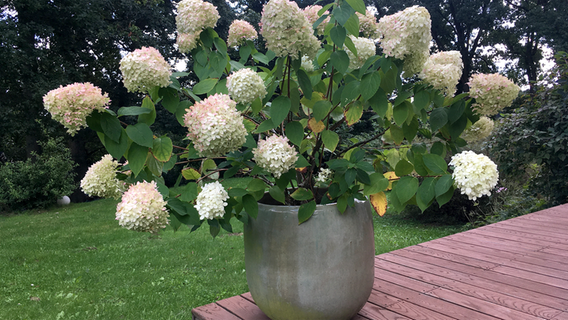
Hydrangeas in pots are an eye-catcher on every terrace.
If you need help watering your balcony plants, you can use a plastic bottle. Poke or drill one or two small holes in the lid of the empty bottle and fill the bottle with water. Screw on the lid and insert it upside down into the soil of the flower pot. The water slowly drips out of the lid and supplies the hydrangea for some time. To be on the safe side, you should try out beforehand whether enough water escapes or whether an additional hole in the lid is necessary.
Planting hydrangeas is best done in late summer
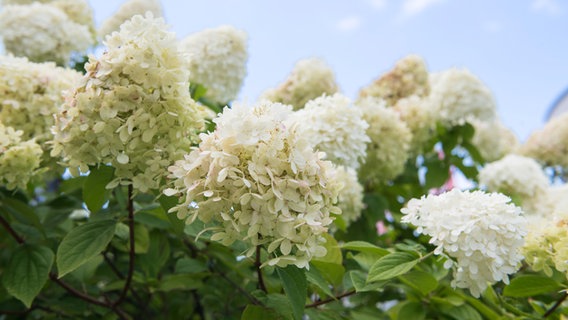
Panicle hydrangeas produce lush, particularly attractive flowers.
A deep, loose and humus-rich garden soil is ideal; the location should be protected from the wind. Before planting, place the hydrangeas in a bucket filled with water for about ten minutes so that the root ball can soak up. The best time to plant is late summer. In this phase, the plants still have many weeks to form roots. In addition, the shapes and colors of the flowers are best assessed when purchasing. Hydrangeas can also be easily propagated from cuttings in summer.
If you are interested in new, unusual varieties, you can take a look at the farmer’s hydrangea “Schloss Wackerbarth”, for example: It has a three-colored flower. “Four Seasons Amethyst” continually changes color during the flowering period. If you are looking for a low-growing hydrangea, “Tovelit” is a pretty specimen.
Cut hydrangeas correctly
When and how severely a hydrangea is pruned depends on the specific species. With the popular farmer’s hydrangea, only frozen or dead shoots should be removed in early spring. If you cut too much, the plant will no longer bloom as profusely or not at all the following summer. If an older hydrangea needs to be rejuvenated, it is worth radically cutting it back to a hand’s width above the ground. The panicle hydrangea, on the other hand, tolerates severe pruning and rewards this with bushy growth and lots of flowers.
Fertilizer gives strength
Special hydrangea fertilizer is available from specialist retailers, but azalea or rhododendron fertilizer is also suitable. Fertilizer should be added between March and July. The fertilizer is nitrogen-based and contains little phosphorus.
Further information
Overwinter hydrangeas
Hydrangeas are generally hardy. To be on the safe side, you should protect them from severe frost with a light winter protection made from brushwood. For potted plants, the container should have a diameter of at least 30 to 40 centimeters. Plants in smaller pots should overwinter in a largely frost-free but cold place at around 3 to 5 degrees.
Further information
Which hydrangeas can be dyed blue?
Blue hydrangeas do not exist naturally – it is the composition of the soil that causes the flowers to turn blue. However, this only works with certain varieties of farmer’s and plate hydrangeas with pink flowers. Pure white or red flowers cannot be recolored. The color change takes some time and is usually only complete in the second year.
Acid soil and alum needed for blue coloring
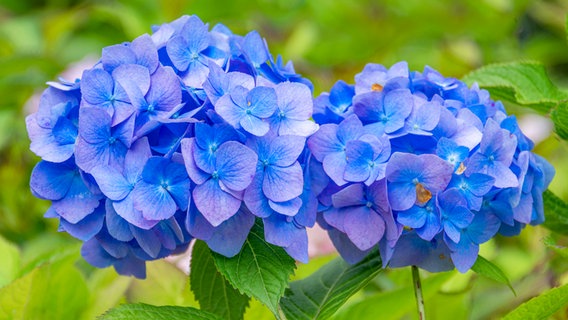
There are no blue hydrangea flowers naturally.
An acidic soil (pH value 4.0 to 4.5), as is important for rhododendrons, is important for blue flowers. Special soil for rhododendrons is therefore recommended for planting in most gardens. For the blue color, alum (aluminum salt) is also required, which is available in garden shops as a combined fertilizer, for example.
In the acidic environment, the plant can absorb the alum and store the dyes in the flowers. To maintain the acidic soil, especially when planting in pots, make sure to only use rainwater or very soft water.
Location and flowering time for different hydrangea species
In addition to the classic farmer’s hydrangea, there are other attractive hydrangea species that stand out due to their special leaf shapes or flowers.
- Panicle hydrangea: It blooms from around August to October. Its mostly white flowers turn green or pink in autumn, depending on the variety. The location can be sunny or partially shaded.
- Forest hydrangea: It is suitable for both sunny and shady places, which are best protected from the wind. The rather inconspicuous flowers appear between June and September.
- Oakleaf hydrangea: It has particularly showy leaves. They are deeply slit and have a beautiful autumn color. The white flowers appear in July and August; the location should be sunny to partially shaded.
- Velvet hydrangea: It has striking velvety, hairy leaves. The purple flowers appear in July and August and provide food for insects. The white wreath of the false flower is particularly striking. The location should be in partial shade if possible.
- Hydrangea: It also has false flowers that attract insects with their color. Flowering time is from July to October. The location can be sunny to partially shaded
- Climbing hydrangea: It is the only one of its genus that can grow up walls, trees or trellises. This type of hydrangea is also popular as a food source for insects. Even in winter it impresses with its special bark structure and color. Climbing hydrangeas grow in sunny and shady locations. Flowering time is from June to July.
Further information


Ethel Purdy – Medical Blogger & Pharmacist
Bridging the world of wellness and science, Ethel Purdy is a professional voice in healthcare with a passion for sharing knowledge. At 36, she stands at the confluence of medical expertise and the written word, holding a pharmacy degree acquired under the rigorous education systems of Germany and Estonia.
Her pursuit of medicine was fueled by a desire to understand the intricacies of human health and to contribute to the community’s understanding of it. Transitioning seamlessly into the realm of blogging, Ethel has found a platform to demystify complex medical concepts for the everyday reader.
Ethel’s commitment to the world of medicine extends beyond her professional life into a personal commitment to health and wellness. Her hobbies reflect this dedication, often involving research on the latest medical advances, participating in wellness communities, and exploring the vast and varied dimensions of health.
Join Ethel as she distills her pharmaceutical knowledge into accessible wisdom, fostering an environment where science meets lifestyle and everyone is invited to learn. Whether you’re looking for insights into the latest health trends or trustworthy medical advice, Ethel’s blog is your gateway to the nexus of healthcare and daily living.
